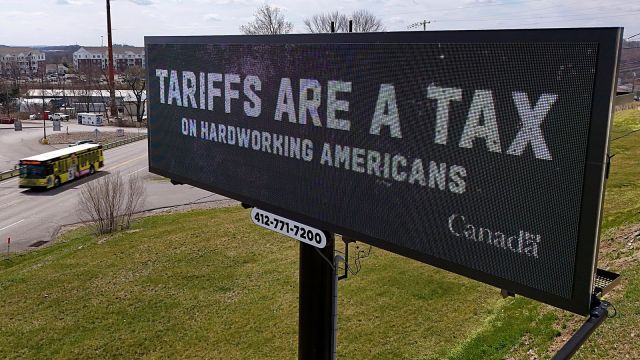Stay updated with the latest - Click here to follow us on Instagram
What’s the maths behind Trump’s tariff rates?
US President Donald Trump had earlier claimed that each country’s tariff rate would be determined based on 'the combined rate of all their tariffs, non-monetary barriers, and other forms of cheating.'
 A chart displayed during the announcement outlined the specific tariff rates imposed on various countries, with Trump explaining that the figures were derived from existing tariffs those nations apply to US exports. (AP photo)
A chart displayed during the announcement outlined the specific tariff rates imposed on various countries, with Trump explaining that the figures were derived from existing tariffs those nations apply to US exports. (AP photo)US President Donald Trump has unveiled a fresh wave of tariffs targeting nearly all of America’s major trading partners, claiming the rates imposed are “reciprocal.” However, the White House has offered limited details on how these calculations were determined.
Trump, who has framed April 2 as “Liberation Day,” described the tariffs as a landmark moment in US economic policy. “This is one of the most important days in American history,” he said during an announcement on Wednesday. The measures affect key economies, including India, and are intended to rebalance what Trump perceives as long-standing trade inequities.
 A chart displayed during the announcement outlined the specific tariff rates imposed on various countries, with Trump explaining that the figures were derived from existing tariffs those nations apply to US exports. “We will charge them approximately half of what they are and have been charging us,” he said, suggesting that the new duties stop short of full parity.
A chart displayed during the announcement outlined the specific tariff rates imposed on various countries, with Trump explaining that the figures were derived from existing tariffs those nations apply to US exports. “We will charge them approximately half of what they are and have been charging us,” he said, suggesting that the new duties stop short of full parity.
How are the tariffs calculated?
The methodology behind Trump’s tariff rates appears to follow this pattern, according to The New York Times:
- Take the trade deficit that the US runs with a particular country.
- Divide that amount by the total exports that country sends to the US.
- Halve the result—because, as Trump put it, he was being “kind.”
This approach suggests that countries with higher trade surpluses against the US receive higher tariffs, while those with a smaller surplus or balanced trade relationship face lower or baseline tariffs.
Financial writer and book author James Surowiecki first identified this pattern in a post on X. His observation quickly gained traction, especially since Trump had earlier claimed that each country’s rate would be determined based on “the combined rate of all their tariffs, non-monetary barriers, and other forms of cheating.”
Just figured out where these fake tariff rates come from. They didn’t actually calculate tariff rates + non-tariff barriers, as they say they did. Instead, for every country, they just took our trade deficit with that country and divided it by the country’s exports to us.
So we… https://t.co/PBjF8xmcuv
— James Surowiecki (@JamesSurowiecki) April 2, 2025
The White House has included non-monetary trade barriers in its justification for the tariffs. These are difficult to quantify and may include:
- Regulations that limit US companies from operating freely in foreign markets.
- Subsidies that give local businesses in other countries an unfair competitive advantage.
- Complicated licensing requirements or bureaucratic delays that make it harder for US firms to export.
Despite these considerations, the tariff formula remains largely rooted in trade deficits, meaning countries that export far more to the US than they import from it are hit hardest.
Are the tariffs an approximation?
While the Trump administration presents these tariffs as a scientific and fair way to rebalance trade, some experts argue, as per The New York Times, that the methodology is simplistic and lacks precision.
Emily Kilcrease, director of the Energy, Economics, and Security Program at the Center for a New American Security and a former deputy assistant US trade representative, noted that coming up with precise reciprocal tariff rate would be a “difficult exercise”.
“Given what seems to be their desire to get something out quickly, it appears what they’ve done is come up with an approximation that is consistent with their policy goals,” she said.
During a briefing with reporters, White House officials stated that the figures were calculated by the Council of Economic Advisers using well-established methodologies. The administration claims that the formula reflects unfair trade practices by foreign countries and ensures that tariffs remain proportional to existing trade imbalances.
What’s next?
With major economies now analysing their responses, the real test will be whether these tariffs achieve their intended effect—or trigger further trade disputes.
Some nations, such as Brazil, have already introduced countermeasures, while others, like Australia, have ruled out retaliation.
(With inputs from The New York Times)































